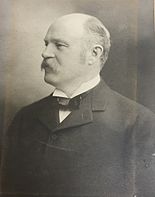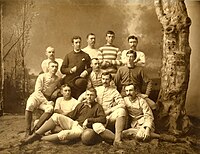History of Michigan Wolverines football in the early years
The university team played its first game against Racine College in May 1879, and Irving Kane Pond scored the first touchdown in Michigan football history.
[13] In October 1874, members of Michigan's University Foot Ball Organization continued their efforts to schedule a game with Cornell, but The Chronicle expressed doubt that it would ever happen.
[31] Another group of 250 students arrived in Detroit on the Saturday morning train from Ann Arbor and walked to Recreation Park to watch the game.
[35] The Chronicle described the playing conditions: "Throughout the whole of the first inning, the rain was increasing, and, joined with a cold wind from the north, soon drenched and all but froze both players and spectators.
The ground was slippery and muddy, the water stood in pools, the ball was soon heavy, and in short circumstances were decidedly against either good playing or enjoyment of it.
[50] The 1884 Albion game was played at the Ann Arbor Fairgrounds as part of an annual field day that included track and field events as well as the "collar and elbow", heavyweight boxing, tug-of-war, Indian club swinging, "catch-as-catch-can wrestling", "passing rugby ball" (won by Thomas H. McNeil with a distance of 116 feet), "chasing greased pig", lawn tennis, and a sprint exhibition by Michigan's national collegiate sprint champion Fred Bonine.
[55] The Detroit Free Press called it a "very exciting and hotly contested game", but the paper criticized the uneven condition of the playing field at the Ann Arbor Fairgrounds.
[63][64][65][66] Michigan was left with the option of playing Albion College and club teams from Detroit, Chicago, and even Windsor, Ontario.
In October 1887, DeHaven wrote to Brother Paul, who ran Notre Dame's intramural athletics program, telling him about the new game of football.
[71][75] The Notre Dame student newspaper, Scholastic, reported: "It was not considered a match contest, as the home team had been organized only a few weeks, and the Michigan boys, the champions of the West, came more to instruct them in the points of the Rugby game than to win fresh laurels.
President Walsh thanked the Ann Arbor team for their visit, and assured them of the cordial reception that would always await them at Notre Dame.
[73] The Notre Dame paper reported: "At 1 o'clock carriages were taken for Niles, and amidst rousing cheers the University of Michigan football team departed, leaving behind them a most favorable impression.
"[82] The paper wrote approvingly of the game: "The spectacle of twenty muscular young men in one colossal heap, struggling, pulling, hauling, pushing, with arms, legs and caps flying in every direction is an exciting and certainly novel one.
While one unaccustomed to foot ball will naturally be startled by some of the acrobatic feats, still it is impossible to watch the game for any length of time without a tingling of the blood and holding of the breath.
The game was played on a wet and muddy field in front of a crowd estimated by various accounts at between 700 and 1,500 spectators at Olympic Park in Toledo, Ohio.
According to the Detroit Free Press, the city was given over to "the U. of M. boys" for the night: "Wherever one turned he was confronted with the din and tumult; the ear-splitting yells from throats with vocal chords of extraordinary vibratory possibilities.
I think the benefit of victory lies in the cultivation of this broad, generous university spirit that pervades all departments and makes us feel here one interest and common joy.
[135] The margin of victory was a surprise as Adelbert had won the Western football championship in 1894 and had narrowly lost to Cornell the previous week by a score of 12 to 4.
Chicago's scoring came on a blocked punt resulting in a safety and a drop kick (worth five points under the rules at the time) by Clarence Herschberger from the 45–yard line.
While the other fields about Chicago were sloppy and the players were floundering about in the seas of mud, the athletes in the Coliseum played on dry surface and secure from the elements.
The Michigan Central Railroad arranged for two special trains to run from Ann Arbor to Chicago,[148] and a crowd of 12,000 spectators attended the game.
"[150] The Chicago Daily Tribune wrote:Widman scurried out of the back of the mass of players with the ball under his arm and down the field with nothing in sight ahead of him except the goal posts.
President Angell spoke to the crowd, expressing support for the team and gratitude "to the men who have won the laurels of our victory from the brow of our sister institution of higher learning.
[146][147][156] In May 1900, newspapers reported that Ferbert had left Ann Arbor for Seattle, where he planned to join two of his former Michigan teammates, to prospect for gold in Alaska.
The Wolverines looked east, hiring Langdon Lea, a four-time All-American from Princeton who was later inducted into the College Football Hall of Fame.
The team opened the 1900 season with six wins, but went 1–2–1 in the final four games, including a scoreless tie against Ohio State and losses to Iowa (28–5) and Chicago (15–6).
"[201] In October 1898, the same publication noted that the band had led a procession up Jefferson and Woodward Avenues when the football team played a game in Detroit in 1897.
Upon arriving in Detroit, the team and students "with the band at the head, marched in double column to the Russell House, which for a number of years has always been athletic headquarters.
[205] At a meeting in the College Chapel on February 12, 1867, the committee made the following report:Your committee, appointed to select emblematic colors for our University, unanimously agree in presenting as their choice, Azure Blue and Maize, and recommend that the following resolution be adopted: 'Resolved, that Azure Blue and Maize be adopted as the emblematic colors of the University of Michigan.
"[218] In his 1920 history of the university, Wilfred Byron Shaw called Pattengill "the moving spirit in the [Western] Conference through many years; and to him, more than to any other, Michigan owes, not only the present effective organization of athletics, but the securing of Ferry Field and its equipment.


























